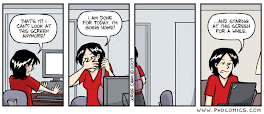Presbyopia is what everybody knows as “old sight”. It is not considered as refractive disorder or an ocular illness.
Vision of presbyopic
The typical complaint in presbyopia is “BLURRED VISION AT CLOSE DISTANCE”. A presbyopic person stretches her arms in order to see better, but in a certain moment “THEY ARE TOO SHORT”.
Distance vision may have not any changes, at least in the first stages.

Appearance of presbyopic eye

The shape of the eye is like a myopic or hyperopic or even emmetropic one at young age; but the difference is given by the crystalline lens. When a person looks at objects up close, she is not capable of focusing them on the retina, but behind (as hyperopic people), therefore seeing them blurred.
Prevalence
Everybody will have suffered presbyopia sooner or later, after 45 years old.
As presbyopia is age-related, its prevalence is higher in societies in which larger proportions of the population survive into old age.
For instance, from all Spanish population, 43% suffers “old sight”. And from this 43%, 7% of presbyopic people have never checked their vision in any previous occasion. Because of the increased life expectancy, within 10 years, more than half of the Spanish population will suffer from this condition.
It does not exist any way tested to be true in order to prevent it.
Symptoms
Incipient presbyopia (the first symptoms)
- It is difficult to maintain the performance of near task in a continuous way.
- Headache because of the continuing effort.
- The letters seem to move on the paper.
- More light is necessary in order to see better.Near vision is worse at the end of the day.
- Sometimes it seems that we “do not control” our eyes (as the accommodation and convergence are related, the gradual loss of accommodation involves the progressive worsening of our fusion, resulting in Convergence insufficiency, and even in a double vision when we are more tired).
Evident presbyopia
- We stretch our arms in order to find the distance where we can read whatever we want, until a certain moment where we do not get to read although we stretch them completely.
- At the beginning presbyopia only affects near distance (documents, handicrafts,…), and little by little it starts affecting intermediate distance too (computer,…)
- We tend to avoid the small texts and precision tasks in near vision whenever we can (we do not sew anymore, we do not read so much, we do not perform certain leisure activities that we liked… :-( )
- We always look for natural light or a good light lamp.
- It is usually accompanied by “Dry eye”.
RELATED POST
Refractive visual disorders. Some clarifications.
Some numbers...
Refractive disorders: Hyperopia , Hypermetropia or Farsightedness. (1) Vision and Accommodation






1 comment:
i absolutely love your own posting type, very unique,
don't quit as well as keep creating as a result it just simply well worth to look through it.
looking forward to read a whole lot more of your own web content, thankx ;)
Post a Comment